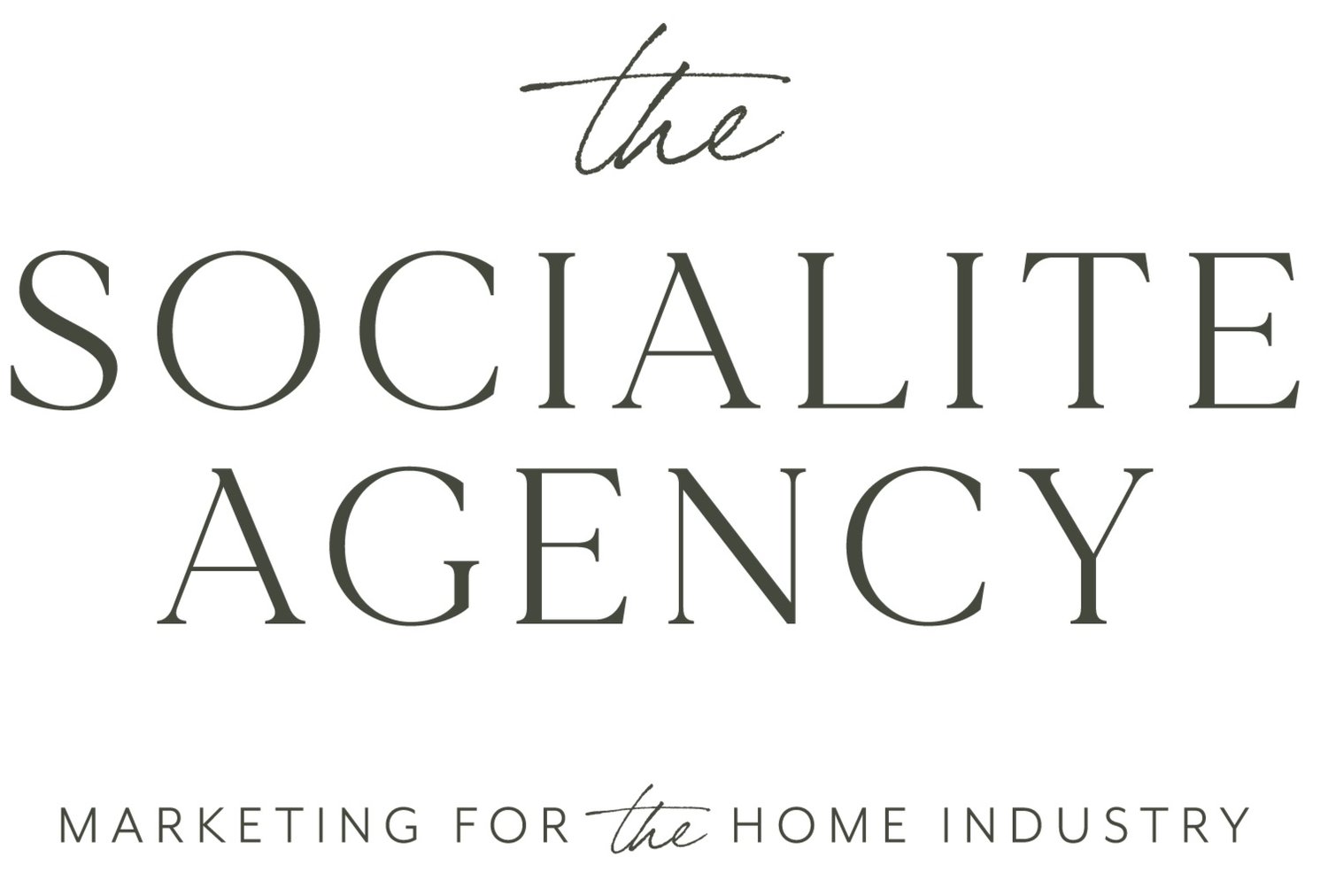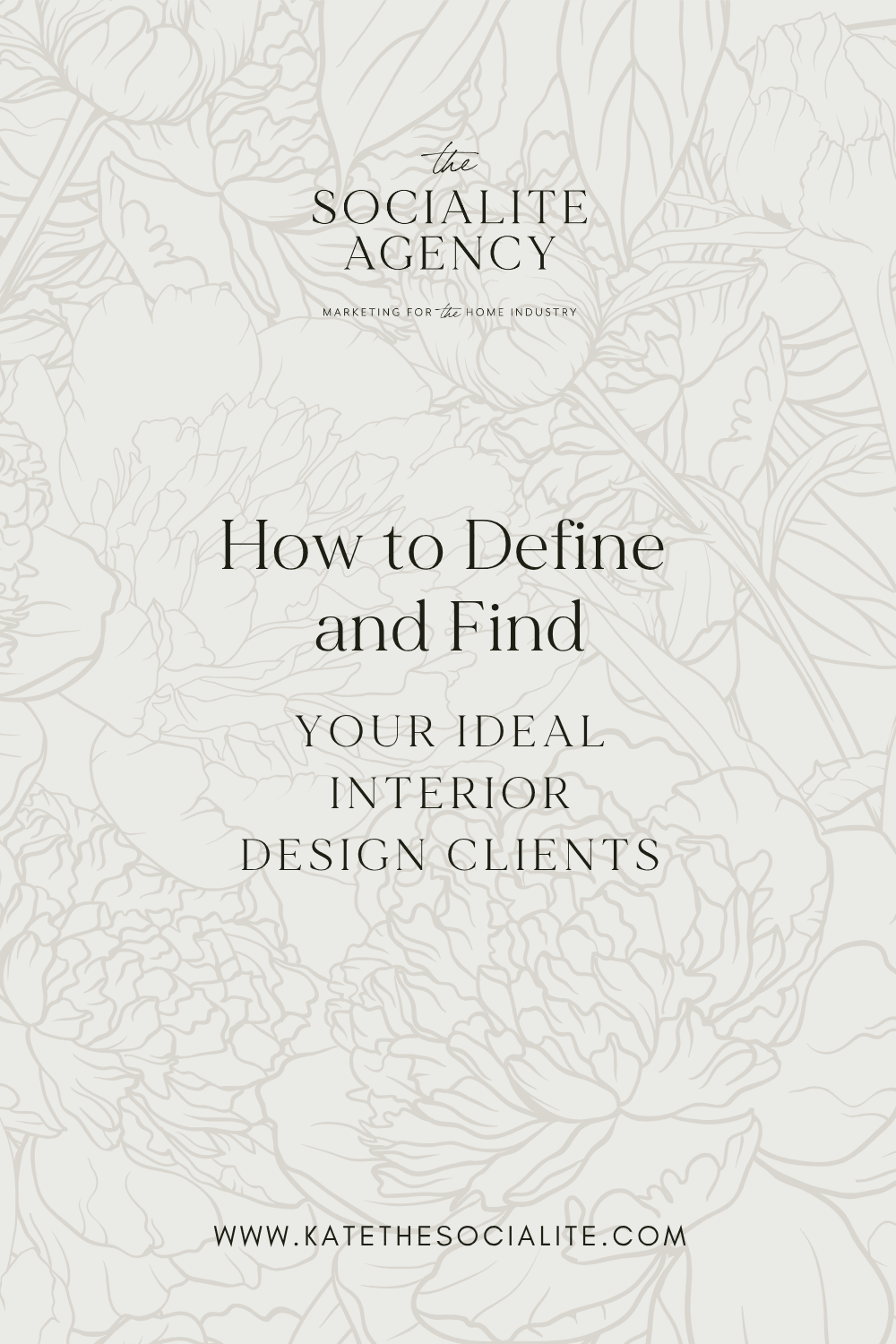How to Define and Find Your Ideal Interior Design Clients
“Do you really know who your ideal client is?”
I ask this question during every single marketing consultation I have with interior designers, home stagers, workroom owners, and professional organizers.
Most often, I get answers like: “I’m not sure who my ideal client is or how to find ideal clients.” OR “I serve anyone in my area who can afford me because my pricing helps filter out bad clients.” (Yes, I cringe a little every time I hear that.)
…but every now and then, I get a response that fills my marketing heart with delight. Something like, “Do I know my ideal client? Yes! And I could tell you what she ate for breakfast this morning.”
That is exactly what I want you to strive for. If you aren’t so in tune with your ideal client that you don’t know his / her lifestyle habits, you will constantly struggle in your marketing and in your business finances. I know that’s blunt…but it is the truth.
Knowing exactly who you’d like to serve, meeting them where they are, tailoring your services to their specific needs, and structuring your marketing accordingly is the key to making business profitable.
So, how do you get from where you are now to that clearly defined ideal client? Let’s talk about how to find ideal clients…
Why You Can’t Rely on a General Concept of Your Ideal Client
Having an ill-defined or overgeneralized concept of your ideal client leads to an unfocused website with a high bounce rate. It means time-consuming social media content with low interaction rates. It means blog posts that feel vague and frankly, very cookie-cutter.
Do any of those things resonate with you? If so, you may currently be serving no one in your business. If you define your ideal client only by their budget and location, you don’t have an ideal client. Chances are high that you’re casting too wide a net…and yielding an unsatisfactory number of fish…if you catch my drift.
How to Find Your Ideal Clients
Now the good news is you don't have to speak to everyone. You just need to speak to one person, and you must understand their needs so that you can properly address them.
When you know exactly who your ideal client is, you’ll find that writing a social media caption, a blog post, a newsletter, and new website copy becomes simple because it’s easier to talk to someone than it is to talk to no one, right?
All you need to do now is grab a pen and paper, write down the answers to the questions coming your way, and let your brain paint a crystal-clear picture of your unique ideal client. This avatar you’re about to build will become the focus of every one of your services and marketing messages going forward.
7 Important Questions to Help Define Your Ideal Client
Question #1: Which Personality Type Meshes Well with Yours?
Think about who you get along with the best. Think of your spouse’s or best friend’s personality. What makes your relationship work so well? A sense of humor? Compassion? Understanding? Shared life experiences? Consider it all.
If you don’t know where to start, it may be helpful to take a personality test. Have an honest conversation with yourself. Determine what attracts you to or repels you from another person. This isn’t prejudice in any way, shape, or form, because there is no room for that in our lives or our businesses, but it does help you determine who you will most enjoy working with day in and day out. And that is important.
Question #2: What Type of Project Do You Most Enjoy?
I know personal preferences can change over time, but in this moment, right now, what type of project do you love? Do you adore creating custom drapery? Can you simply not get enough time staging occupied homes? Are you drawn to interior design projects for stay-at-home moms or on-the-go businesspeople?
There is no wrong answer here. But do try to limit your choices to one or two types of projects, as we want to stay focused. Plus, as you move forward in marketing yourself and your business, these one or two types of projects will become known as your signature services. So, choose wisely!
Question #3: What Skills Do You Have that Set You Apart?
There is something about you that makes you perfectly suited for your job. It may be a skill that is totally unrelated to your field, or it may mesh perfectly with the work you do. Give yourself the credit you deserve here…
Maybe you can make strangers feel like old friends in a way that they open up to you casually and comfortably. Maybe you have an uncanny ability to thoroughly estimate projects and then work the numbers to stay within client budgets.
Whatever it might be, that skill is your unique selling point. Use it!
Question #4: What Types of Problems are You Most Adept at Solving?
Based on the types of projects you really enjoy, the personalities that you jive well with, and the special skill(s) that you just listed, consider the problems you are best able to solve for clients. What issues are you uniquely positioned to offer solutions for that might set you apart from others in your industry.
And once you’ve pinpointed the problems, label their corresponding emotions. Are you helping alleviate fear? Removing overwhelm? Reducing stress? It is the emotion, or the end result that will sell your work to clients. They want that feeling of freedom, accomplishment, joy, comfort, etc. So, when you are talking about your special problem-solving abilities, focus more on the emotional impact than on the deliverables.
Question #5: Can You Describe the Person that Experiences These Problems and Emotions?
Let’s dive a bit deeper into your particular ideal client. If someone is having the problem that you are really good at solving, how old do you think they are? What income do they make? What career field do they work in? What is their family situation? Where are they located?
All of these questions help you start to develop that clear picture of your ideal client.
Question #6: What is this Same Person Posting About on Social Media?
Even if you’re getting a clear understanding of your ideal client’s life situation and personality, you may still be wondering how to speak their language. Go check out what they are posting on Facebook, pinning on Pinterest, and following on Instagram.
You’ll start to develop an idea of what their hobbies are, how they spend their free time, what they dream of in the future, and possibly even their personal style.
When you’ve nailed down your ideal client’s interests, hobbies, and dreams, you can really start speaking directly to those things in your marketing.
Question #7: What is Most Important to this Person and How Do Your Services Fit In?
You likely know the various facets of your ideal client’s life. Now, it is up to you to rank their priorities, as you see them. Family? Career? Entertaining? Style? Volunteering? Travel? Hobbies?
Your service offerings should align with your ideal client’s top priorities. If they don’t seem to line up right now, it may be that your services need some reworking. Or it might simply be as easy as a wording change, helping your ideal clients feel that the services you currently offer are perfectly tailored to their exact needs.
How This Process of Niching Down Will Help Your Business
Now, if you are anything like the people I’ve had this same conversation with over the years, you may be worrying that positioning your business and services around one particular type of person will alienate others.
But the truth is that you aren’t alienating others. You are simply specializing in your ideal client and their needs. This will allow you to charge more for your services, dive deeper into each client’s needs, and deliver more value with each project.
The more you can understand every intimate detail of your ideal client, the more you can specialize, the more you will profit, and the more you will ultimately help transform each of your clients’ lives.
And if I may offer one last tidbit of advice when it comes to speaking your ideal client’s language, you must have a firm grasp of his or her top priorities and greatest fears. Because chances are, your services can be built around both alleviating those fears and matching those priorities. Doing so will make your marketing easier, keep your pipeline fuller, and increase your profits considerably.
Until next time,
Kate


